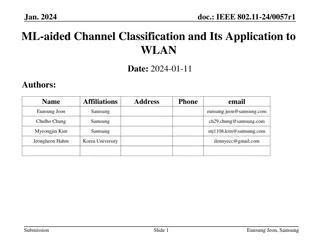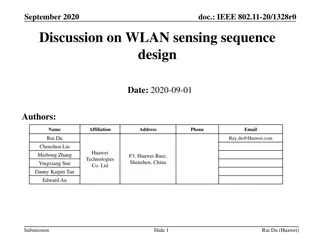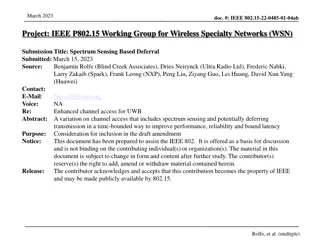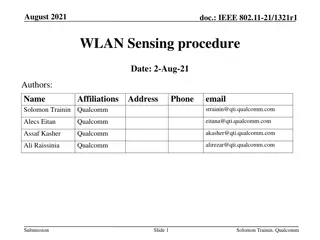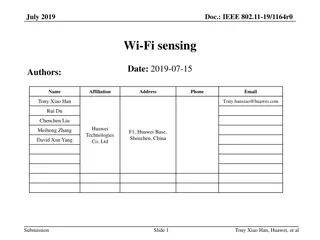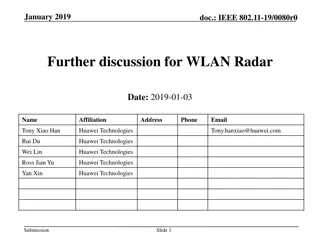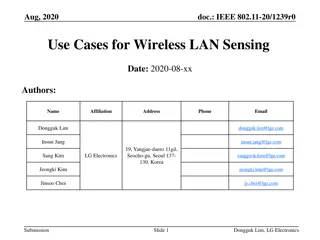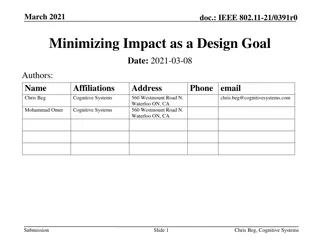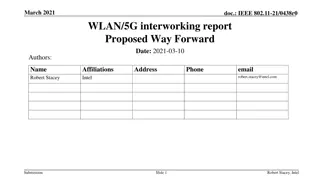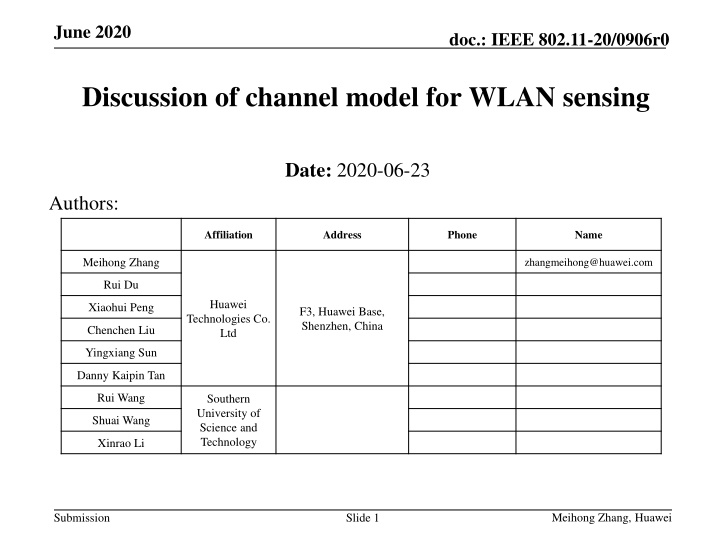
Channel Modeling for WLAN Sensing at Different Frequency Bands
Explore the necessity and strategies for channel modeling in WLAN sensing at various frequency bands, including sub-7 GHz and 60 GHz. The document discusses the importance of channel modeling for IEEE 802.11 standards like 802.11n, 802.11ac, 802.11ax, and 802.11be. It also delves into the requirements and approaches for achieving higher throughput and enhancing multi-antenna models.
Download Presentation

Please find below an Image/Link to download the presentation.
The content on the website is provided AS IS for your information and personal use only. It may not be sold, licensed, or shared on other websites without obtaining consent from the author. If you encounter any issues during the download, it is possible that the publisher has removed the file from their server.
You are allowed to download the files provided on this website for personal or commercial use, subject to the condition that they are used lawfully. All files are the property of their respective owners.
The content on the website is provided AS IS for your information and personal use only. It may not be sold, licensed, or shared on other websites without obtaining consent from the author.
E N D
Presentation Transcript
June 2020 doc.: IEEE 802.11-20/0906r0 Discussion of channel model for WLAN sensing Date: 2020-06-23 Authors: Affiliation Address Phone Name Meihong Zhang zhangmeihong@huawei.com Rui Du Huawei Xiaohui Peng F3, Huawei Base, Shenzhen, China Technologies Co. Ltd Chenchen Liu Yingxiang Sun Danny Kaipin Tan Rui Wang Southern University of Science and Technology Shuai Wang Xinrao Li Meihong Zhang, Huawei Submission Slide 1
June 2020 doc.: IEEE 802.11-20/0906r0 Outline 1. Abstract 2. The necessity of channel modeling at sub 7 GHz - 2.1 IEEE 802.11n - 2.2 IEEE 802.11ac - 2.3 IEEE 802.11ax - 2.4 IEEE 802.11be 3. The necessity of channel modeling at 60 GHz - 3.1 IEEE 802.11ad - 3.2 IEEE 802.11ay 4. How about for SENS ? 5. Conclusion 6. References Meihong Zhang, Huawei Submission Slide 2
June 2020 doc.: IEEE 802.11-20/0906r0 1. Abstract In [1], the potential documents that SENS SG (or the future TG) would consider and prepare was presented, including - Usage models, channel models, evaluation methodology, functional requirements and so on. In this contribution, the following point will be further discussed: - The necessity for WLAN Sensing channel modelling. Meihong Zhang, Huawei Submission Slide 3
June 2020 doc.: IEEE 802.11-20/0906r0 Outline 1. Abstract 2. The necessity channel modeling at sub 7 GHz - 2.1 802.11n - 2.2 802.11ac - 2.3 802.11ax - 2.4 802.11be 3. The necessity channel modeling at 60 GHz - 3.1 802.11ad - 3.2 802.11ay 4. How about for SENS ? 5. Conclusion 6. References Meihong Zhang, Huawei Submission Slide 4
June 2020 doc.: IEEE 802.11-20/0906r0 2.1 The necessity of 11n channel modeling Goal [2]: - Targets >=100Mbps MAC SAP throughput; Necessity: - Extended SISO scenarios based on [3,4] and new multiple antenna models are proposed. - Parameters need to be modified, such as correlation matrices, etc.. How: - - - - Start with delay profiles of models B-F; Manually identify clusters in each of the five models; Determine tap powers; Assume power angular spectrum shape, angular spread, mean AoA (AoD) of each cluster and corresponding taps; Assume antenna configuration; Calculate correlation matrices for each tap. - - Meihong Zhang, Huawei Submission Slide 5
June 2020 doc.: IEEE 802.11-20/0906r0 2.2 The necessity of 11ac channel modeling New Goal [5]: - Targets >1Gbps MAC SAP throughput. Necessity : - Parameters need to be modified, such as channel sampling rate for larger bandwidth, AoAs and AoDs for Multi-User case and so on. How: - Based on the channel modelling approach used by 11n, some modifications are proposed, including 1) a method for reducing power delay profile tap spacing; 2) a way for generating Per-User AoA and AoD offsets for MU-MIMO channel model; 3) Doppler components; Meihong Zhang, Huawei Submission Slide 6
June 2020 doc.: IEEE 802.11-20/0906r0 2.3 The necessity of 11ax channel modeling New Goal [6]: - Targets to enhance the average throughput per station in both indoor and outdoor operations. Necessity: - Parameters need to be modified, such as penetration loss for indoor scenarios, sampling rate for supporting 160MHz or wider bandwidth for outdoor scenarios, etc.. How: - - Indoor scenarios: Same as TGn and TGac spatial channel models. Outdoor scenarios: Adopt ITU-R Urban Micro (UMi) channel models and ITU-R Urban Macro (UMa) channel models as the baseline. Meihong Zhang, Huawei Submission Slide 7
June 2020 doc.: IEEE 802.11-20/0906r0 2.4 The necessity of 11be channel modeling New Goals [7]: - Targets >=30Gbps MAC SAP throughput; - Carrier frequency operation between 1 and 7.250 GHz. Necessity: - Potential features such as wider bandwidth support, more spatial streams, multi-AP coordination and multi-band/channel operations are identified. - Parameters need to be modified, such as correlation matrices for more than 8 antennas and so on. How: - Still to be discussed. Meihong Zhang, Huawei Submission Slide 8
June 2020 doc.: IEEE 802.11-20/0906r0 Outline 1. Abstract 2. The necessity channel modeling at sub 7 GHz - 2.1 802.11n - 2.2 802.11ac - 2.3 802.11ax - 2.4 802.11be 3. The necessity channel modeling at 60 GHz - 3.1 802.11ad - 3.2 802.11ay 4. How about for SENS ? 5. Conclusion 6. References Meihong Zhang, Huawei Submission Slide 9
June 2020 doc.: IEEE 802.11-20/0906r0 3.1 The necessity of 11ad channel modeling New Goal [8]: - Developing a new channel model for 60 GHz WLANs systems. Necessity: - The propagation characteristics of signals for 60 GHz frequency band are different from the sub 7GHz band. - Even though some of IEEE 802.15.3c channel models can be reused, there are still some additional measurements need to be done [9]. How: - - Considering both LOS and NLOS; Time and angular characteristics are calculated from Ray Tracing simulations, then the probability density functions (PDFs) estimated by approximation. Polarization impact is also calculated by ray tracing simulations then approximated to create statistical models; Probabilities of blockage events for different number of clusters were estimated. - - Meihong Zhang, Huawei Submission Slide 10
June 2020 doc.: IEEE 802.11-20/0906r0 3.2 The necessity of 11ay channel modeling New Goals [10]: - Enhancing the efficiency and performance of existing IEEE 802.11ad specification; - Considering more complex scenarios, including dynamic outdoor environment, various SU- and MU-MIMO modes. Necessity: - Scenarios included in 11ad are extended to MIMO systems; - Propagation channel in outdoor environment including non-stationary and mobility effects are supported. How: - - - - Three new concepts of rays are introduced, named D-rays, R-rays, F-rays; All possible clusters parameters can be calculated by ray tracer algorithm ; Intra-cluster rays arrival time is a Poisson process. Human blockage effect and Polarization impact are also considered. Meihong Zhang, Huawei Submission Slide 11
June 2020 doc.: IEEE 802.11-20/0906r0 4. How about for SENS ? New Goals: - Sensing performance should be considered and compared at both sub 7 GHz and 60 GHz; - Should communication performance be considered and compared as well with the newly added sensing function? Necessity: - Models are critical to benchmark the performances which can be assessed in lower layer, such as Range/Angular/Velocity Resolution, Range/Angular/Velocity Accuracy, These performances are positively related with our final performances (recognition accuracy, etc.). - New representative scenarios including moving target(s) should be considered, For different operating frequency bands, sub 7GHz and 60GHz; For different applications, like human walking, gesture recognition, etc.. For different configuration, such as mono-static, bi-static, - New performance (e.g., sensing performance) should be focused on or should be included, moving target(s) is considered in previous standard, such as 11ad/ay, they just consider the impact of blockage caused by moving target on communication performance. Meihong Zhang, Huawei Submission Slide 12
June 2020 doc.: IEEE 802.11-20/0906r0 4. How about for SENS ? Some discussions on WLAN Sensing channel modelling: If a new channel model for Sensing is needed, what kind of model should it be? - A "new" channel model extended from existing models? Or a totally new channel? For a "new" channel model extended from existing models, what can we learn from the models in 11n, 11ac, 11ax, 11ad and 11ay? - The antenna configuration? The polarization effect? Pathloss and oxygen absorption [10]? Or others? For a totally new channel model, - How? TBD. Other discussions: - The power of reflected signal from device free targets depends on its RCS which impacts the sensing performance, so the factors affect RCS need to be considered [11], such as Target materials and shape; Illuminating and observing angles; - The spatial-temporal correlations of the environment and moving targets also need to be considered [12]. Meihong Zhang, Huawei Submission Slide 13
June 2020 doc.: IEEE 802.11-20/0906r0 5. Conclusion In this presentation, the necessity of channel modelling for both sub 7 GHz and 60 GHz are analysed. Some initial thinking about the necessity of channel modelling for SENS are presented and discussed. Meihong Zhang, Huawei Submission Slide 14
June 2020 doc.: IEEE 802.11-20/0906r0 6. References [1] 11-20-0602-01-SENS-discussion-on-wlan-sensing-draft-amendment-development-process.pptx [2] 11-03-0940-04-000n-tgn-channel-models.doc [3] J. Medbo and P. Schramm, Channel models for HIPERLAN/2, ETSI/BRAN document no. 3ERI085B. [4] J. Medbo and J-E. Berg, Measured radiowave propagation characteristics at 5 GHz for typical HIPERLAN/2 scenarios, ETSI/BRAN document no. 3ERI084A [5] 11-09-0308-12-00ac-tgac-channel-model-addendum-document.doc [6] 11-14-0882-04-00ax-tgax-channel-model-document.docx [7] 11-19-0359-00-0eht-tgbe-channel-model-document.docx [8] 11-09-0334-08-00ad-channel-models-for-60-ghz-wlan-systems.doc [9] 11-08-0632-00-0vht-60ghz-channel-model-recommendation.ppt [10] 11-15-1150-09-00ay-channel-models-for-ieee-802-11ay.docx [11] Skolnik M I. RADAR systems[M]. McGraw-Hill, NY, 2001. [12] Bourdoux A , Barreto A N , Van Liempd B , et al. 6G White Paper on Localization and Sensing [J]. 2020. Meihong Zhang, Huawei Submission Slide 15






